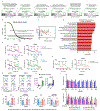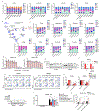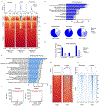Lactate is an epigenetic metabolite that drives survival in model systems of glioblastoma
- PMID: 35948010
- PMCID: PMC9391294
- DOI: 10.1016/j.molcel.2022.06.030
Lactate is an epigenetic metabolite that drives survival in model systems of glioblastoma
Abstract
Lactate accumulates to a significant amount in glioblastomas (GBMs), the most common primary malignant brain tumor with an unfavorable prognosis. However, it remains unclear whether lactate is metabolized by GBMs. Here, we demonstrated that lactate rescued patient-derived xenograft (PDX) GBM cells from nutrient-deprivation-mediated cell death. Transcriptome analysis, ATAC-seq, and ChIP-seq showed that lactate entertained a signature of oxidative energy metabolism. LC/MS analysis demonstrated that U-13C-lactate elicited substantial labeling of TCA-cycle metabolites, acetyl-CoA, and histone protein acetyl-residues in GBM cells. Lactate enhanced chromatin accessibility and histone acetylation in a manner dependent on oxidative energy metabolism and the ATP-citrate lyase (ACLY). Utilizing orthotopic PDX models of GBM, a combined tracer experiment unraveled that lactate carbons were substantially labeling the TCA-cycle metabolites. Finally, pharmacological blockage of oxidative energy metabolism extended overall survival in two orthotopic PDX models in mice. These results establish lactate metabolism as a novel druggable pathway for GBM.
Keywords: ATAC-seq; ChIP-seq; glioblastoma; lactate; metabolic flux analysis; tumor metabolism.
Copyright © 2022 Elsevier Inc. All rights reserved.
Conflict of interest statement
Declaration of interests The authors declare no competing interests.
Figures







References
-
- Alistar A, Morris BB, Desnoyer R, Klepin HD, Hosseinzadeh K, Clark C, Cameron A, Leyendecker J, D’Agostino R Jr., Topaloglu U, et al. (2017). Safety and tolerability of the first-in-class agent CPI-613 in combination with modified FOLFIRINOX in patients with metastatic pancreatic cancer: a single-centre, open-label, dose-escalation, phase 1 trial. Lancet Oncol 18, 770–778. 10.1016/S1470-2045(17)30314-5. - DOI - PMC - PubMed
-
- Burgess EA, and Sylven B (1962). Glucose, lactate, and lactic dehydrogenase activity in normal interstitial fluid and that of solid mouse tumors. Cancer Res 22, 581–588. - PubMed
Publication types
MeSH terms
Substances
Grants and funding
LinkOut - more resources
Full Text Sources
Other Literature Sources
Molecular Biology Databases

